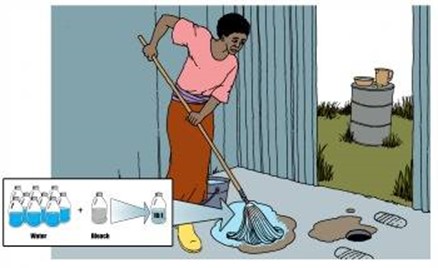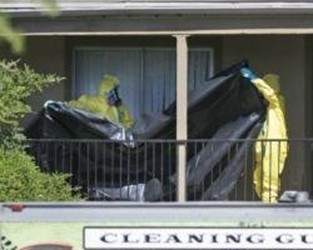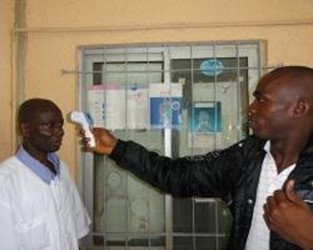Ebola is not over. As it becomes more clear that Ebola is firmly a worldwide problem, there may have been unintentional exposure to hundreds of people outside of the hot zone. To be prepared, you should have a few things on hand that will keep you safer than without them. Ebola is a serial killer and will take every possible opportunity to kill those who come to help. But like any war, we have weapons too, and they are in the strategic categories of identification, defense, attack, and containment. There is also an amount of practicality on this list.
By Doc Montana, a contributing author of Survival Cache and SHTFBlog
It contains nothing that costs more than a few dollars. Everyone should have these materials on hand since unintentional exposure is always accidental. Therefore your planning time is now, and you will likely be on your own if this goes downhill fast.
Finally, do not take this list as anywhere near adequate to work with an Ebola-infected patient. Instead this list is designed to reduce your chance of exposure in public, and to make a last-ditch effort to prevent further spread should Ebola hit close to home. More elaborate barrier methods including disposable Tyvek suits and full-face respirators will certainly better your odds, but only if you have them, replace them often, and have enough of them to outfit your family or community.
The Shopping List
Bleach: Chlorinated water has been proven an effective disinfectant for Ebola. For best results mix 1:10, or one part bleach to ten parts water (not the one to nine as is often written). So a one-gallon bottle of household bleach (i.e. Clorox) will provide eleven gallons of disinfectant. Only mix as needed since the diluted bleach loses its strength over a day or two depending on temperature and air exposure. And paradoxically, diluted bleach is a better disinfectant than concentrated bleach, so more is not necessarily better. And keep the area or thing to be disinfected moist with the bleach solution for minutes rather than seconds. At least 10 minutes if you can.

Gloves: The professionals use heavier, thicker gloves, but that is because they are intentionally entering an Ebola theater. Your prevention needs will be served fine with Nitrile or latex exam gloves. They should fit snugly and be replaced often. To remove the gloves, pinch the glove at the wrist with one gloved hand and then pull the glove off the hand turning it inside out. For the other hand, slide your bare thumb under the other glove at the wrist and pull off the glove without touching its outside surface. Of course you should soak your gloved hands in the bleach solution prior to removal, and rinse your bare hands again afterwards. And since the exam gloves are like giant rubber bands, watch out for flying material as the gloves are stretched and removed.
Masks: There are three main mucous membrane areas on the human face; the mouth, nose and eyes and all are like wide open doors into your body. Particle masks with a minimum rating of N-95 can offer reasonable light protection from Ebola. While an N-100 mask is arguably better, the fit and ability to change the mask often is more important unless you plan on deliberately entering an Ebola facility. Plus N-100s cost much, much more than N-95s so they probably won’t be changed as often as they should be.
Eye Wear: With the mouth and nose covered, the eyes need some help. Eye wear or a transparent face mask does two main things. First, it keeps unintentional Ebola virus from reaching your eyes when virus-contaminated liquid droplets splash, squirt, spray, or projectile in your direction from another person or source. The second thing is that eye wear helps to keep your own fingers out of your own eyes. It is easy and habitual to touch your own face, so in many ways the mask and eye wear protect you from yourself. You don’t need anything fancy unless deliberately encountering Ebola, good shop glasses or lab goggles are fairly effective. Even prescription glasses or sunglasses are better than nothing, but like wood chips or metal flakes flying around the tool shop, the virus can hit you from the side, bottom or top landing right in your eye. Then its game over.
Alcohol: The CDC has found that the Ebola virus can be killed by many common disinfectant agents. They also advise using waterless alcohol disinfectants that are popular these days. Keep in mind three things: 1) Disinfectants are only helpful if used, so having them is not the same as regularly using them. 2) Soap, running water and vigorous scrubbing is more effective so consider the alcohol only a stopgap measure until a proper washing can take place. And 3) Many other fluids contain alcohol, bleach, hydrogen peroxide, or acetic acid (vinegar). Just remember that Ebola, while not a particularly durable virus that will die within a day without a host, does put up a fight so using something like using methyl alcohol gasoline additives (Heet, etc.) as disinfectants will require more time than if a bleach solution was used. And be careful because garage or kitchen decontamination solutions may dissolve other plastic barriers or gloves as well as acting like solvents providing the virus a faster pathway through membranes and even skin.
Duct Tape: Plastic tape and duct tape will provide an effective barrier if sealed tightly. Disinfection procedures should be followed both before and after the removal of the duct tape because the tape can provide protection to the virus in first-round of decon if it gets trapped between layers or behind corners.

Plastic Sheeting: Whether drop cloth, ground cloth, or plastic tarp, you can use the material for many last ditch efforts to isolate an area of your home, and make impromptu body bags. Use the duct tape to secure the sheeting for isolation, and notice the direction of airflow with the goal to vent contaminated areas to the outside. Even though Ebola is not airborne like the flu, it does easily catch rides on other materials as they are moved about.
Gasoline or Diesel:
Gas is not just for your bug out vehicle, but also for incinerating ebola-infected materials and bodies. While Ebola will die just fine in a few hours to 24 hours (but give it 48 hours just to be sure) if the Ebola is contained in a fluid that came from an infected person, it remains biologically hot for much longer. Incineration is an effective way to kill Ebola, and everything else for that matter. Just don’t do anything stupid while moving the hazardous items to your burn pit.

Thermometer: An elevated human body temperature is one of the first objective symptoms of an Ebola infection. Therefore the humble thermometer should be used often and effectively to locate those who might be infected within your family, group, or community. The time for concern is when the body temperature reaches 100.4 degrees F or 38 degrees C. And remember that a clean bill of health should only be assigned when a person is exposure-free and symptom-free for a full three weeks.
Paper Towels: You will need to use something to wipe down and dry off surfaces and body parts. Paper towels are a better solution since linens require management and storage until properly washed. Paper towels can be burned quickly, buried or sealed in plastic bags.
Plastic Garbage Bags: If hazmat materials cannot be burned immediately, or are made of plastic, you will need to contain them. Everything on this list will need to be disposed of properly or burned. High quality, thick trash bags are a realistic solution to the problem of storage and disposal of potentially contaminated materials. This is not the time to buy the cheap ones. Don’t overload the bags, or drag them causing holes in the plastic. And don’t just toss them outside since wandering animals of both the wild and formally domestic variety may consider your Hot Zone a free lunch. Note, however, that the CDC has never received a report of a dog with Ebola.
Also Read:
15 Preparedness Uses for Kiddie Pools
Get Ready
The above list is incomplete and inconclusive. It is not a substitute for proper knowledge and common sense. This list is, however, designed to provide you with basic supplies on hand that will make a difference. Good luck.
Further reading on the subject should include the military manual on decontamination, and CDC’s flyer on Ebola:
Decontamination of Vehicles Used To Transport Ebola Patients (Click Here)
CDC – What You Need To Know About Ebola (Click Here)
Start now to make sure you are staying prepared.
Via : survivalcache




 Follow
Follow
Leave a Reply